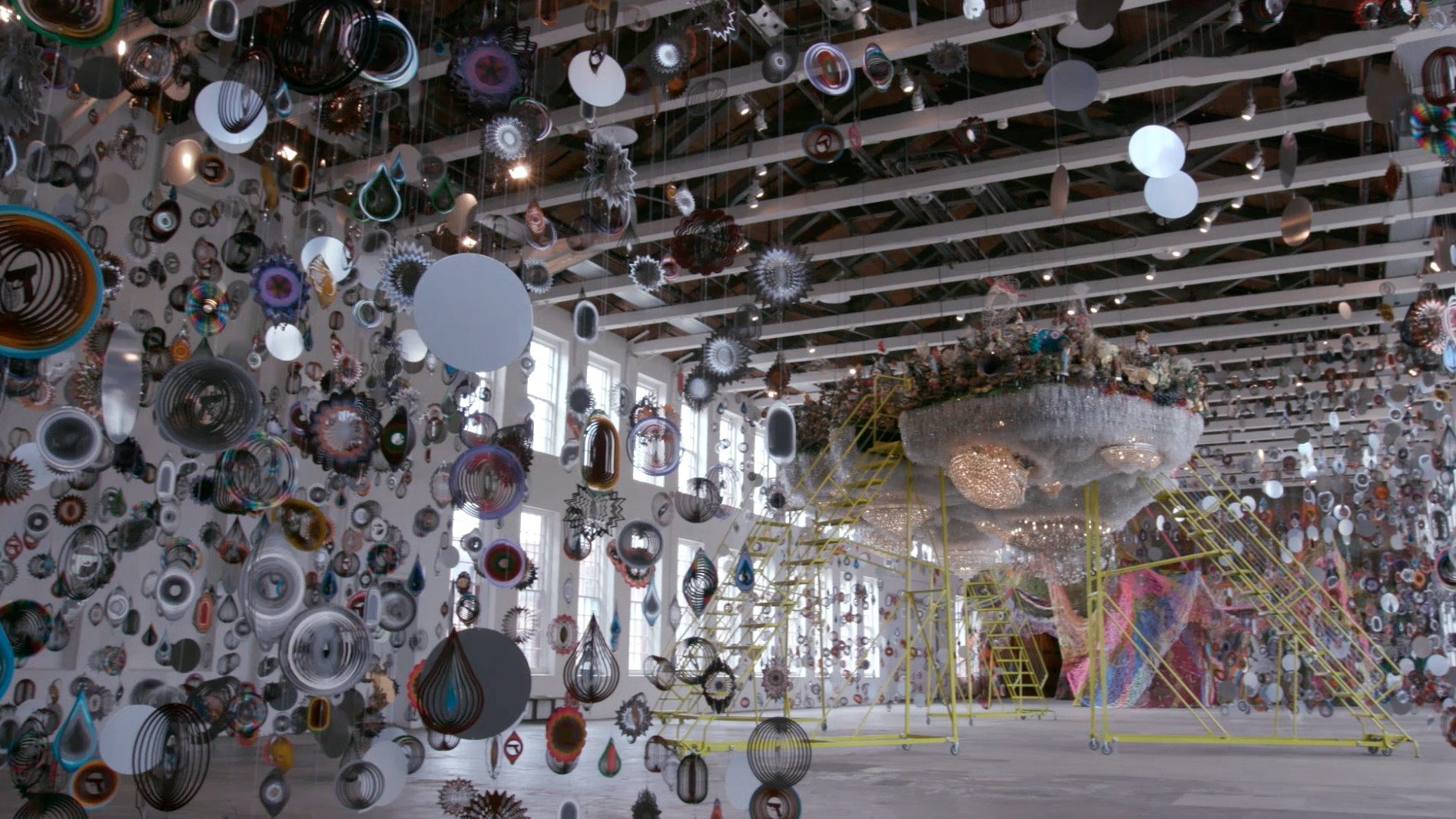The author (left) and artist Nina Chanel Abney (right) at Mary Boone Gallery
Nina Chanel Abney, Untitled, 2017. From Seized the Imagination at Jack Shainman
Abney: That’s still the case—none of these [paintings] were planned out ahead of time, so it’s all intuitive. I feel like I work intuitively because if I planned it out ahead of time I’d be bored. So I feel like it keeps me interested in the work as I’m making it. That’s pretty much why I just go for it, so I keep myself challenged. Like I don’t plan any of the paintings out, but I at least come up with a general idea of what I want to make a painting about.Does that idea evolve while you work?
I usually stay under the general main idea, but as I’m working, anything could happen in the work, which I like because it keeps it very current. So that’s how I can make a painting where something that could have happened two weeks ago is in the work.

How are the works in these two simultaneous shows related?
I found an artist who makes fake art therapy books. And the title of one of his pieces is How to Feel the Way You Felt Before You Knew What You Know Now. So [the show at Jack Shainman] is the chaos of what you know now, and the work at Mary Boone’s is kind of like how you felt before.We could leave here, one of us could get pulled over by the cops, and it could instantly be an incident. But then after that, where would you go? You might go work out the next day. [The Mary Boone paintings are] just more reflective of our day-to-day—that we have these chaotic things happening, but we have these things from our daily life that occur in between.
Nina Chanel Abney, White River Fish Kill, 2017. From Seized the Imagination at Jack Shainman
The author (left) and artist Nina Chanel Abney (right) at Jack Shainman
Out of all the paintings, this is the one where I took the actual image and then switched out the figures. I typically do that to kind of take it away from what it was initially.The cops are black in your painting.
Yeah.You’ve talked about the struggles of painting black figures, which are so often read to be inherently political in the art world. How do you deal with that?
That’s why I work the way I do, where I switch out the [races]. I will mix genders, race, and figures. Just to broaden the story, so just because this person’s black, you don’t just assume one set story to the painting.I’m always trying to expand people’s minds beyond one set definition. What I’ve learned is that a lot of people want to view a painting, and they want the answer right away. So I’m constantly trying to figure out ways to challenge that.
Nina Chanel Abney, detail of Untitled, 2017. From Seized the Imagination at Jack Shainman
Nina Chanel Abney, Request One Zero One, 2017. From Safe House at Mary Boone Gallery
Nina Chanel Abney, detail of Untitled, 2017. From Seized the Imagination at Jack Shainman
The way I paint now is really driven by social media and how we take in information now. I try to reflect that chaos. We take in so many different things at one time: You scroll down your timeline, someone died, and you’re like, “Oh, that’s sad.” And then you go down, and your friend’s at a party, and you’ve forgotten about that previous post in a second. So I wanted my paintings to kind of reflect all of that information in one spot.
Yeah. I felt like if we had to sit down for a minute and really actually process the information, what would that be like? So if I can present it in a way that makes it feel like one narrative, it forces us to consider what all this means together.
Nina Chanel Abney, Penny Dreadful, 2017. From Seized the Imagination at Jack Shainman
Installation view of Safe House at Mary Boone Gallery
Nina Chanel Abney, All These Flavors and you choose to be salty, 2017. From Seized the Imagination at Jack Shainman
Oh yeah, for sure. All the symbols and things I use in the work. Another way of me challenging one defined answer is in creating a shape or something that could mean multiple things depending on who’s looking at it.Are you trying to create a visual language that’s as universal as emojis are?
I’m just trying to create a language that’s simplified, where anyone can come into the show from any background and read into the work in a way that they can relate to, just like an emoji.Given the political climate, do you feel any responsibility to communicate anything specific to audiences?
I’m not trying to dictate any specific message to the viewer. I obviously have my opinions on the things that are happening, but I at least just want to start a conversation around it. Someone could send me negative feedback based on what the subject matter is, and that’s OK. It doesn’t mean I agree with it, but at least… I welcome all opinions.Seized the Imagination was on view at Jack Shainman Gallery through December 20. Safe House was at Mary Boone Gallery through December 22. Learn more about Nina Chanel Abney on her website.Follow Gabrielle Bruney on Twitter.